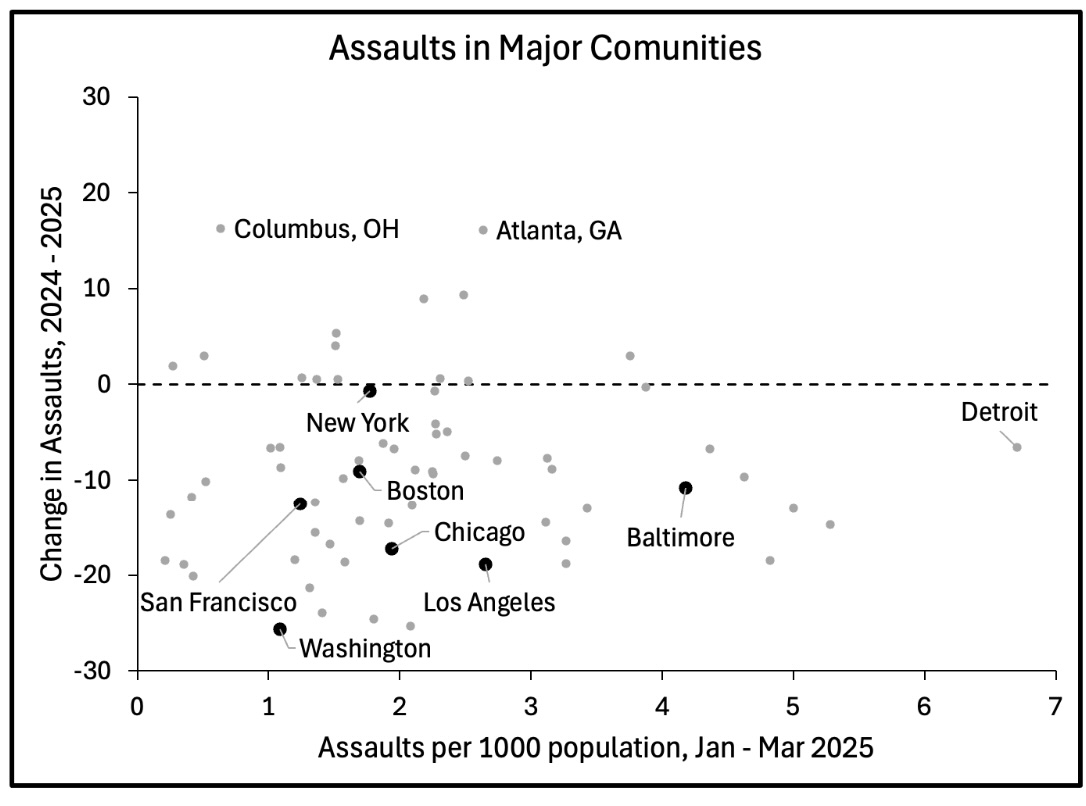What you need to know
Considerable news attention in recent months has focused on crime rates in major urban areas, including Washington, San Francisco, New York, Boston, Los Angeles, Chicago, and Baltimore. The current administration has suggested that National Guard deployments to these cities might be an appropriate way to address this problem. Our analysis explores a few basic questions:
- What is the overall trend in urban crime?
- Across the country, which urban areas have high crime rates?
- Are there some communities where crime is increasing (or decreasing) at an unusual rate?
The trend in crime
The most up-to-date data on urban crime is reported by the Major Chiefs Association, a group of police commissioners from 66 large cities and high-population counties. In this brief, we analyze their data from the first quarter of 2025 (January-March).
The Major Chiefs data includes counts of murders, burglaries, rapes, and aggregated assaults. While most media stories on urban crime focus on murder rates, these statistics are not necessarily the best indicator because murder is a relatively rare crime, so the change in murder rates from year to year is largely random. In general, from 2024 - 2025, murder rates declined in most large cities, including 22.3% in Baltimore, 32% in Chicago, 28.9% in Los Angeles, 26.6% in New York, 35% in San Francisco, and 4.5% in Washington, DC.
A better potential way to measure overall crime is to focus on the rate of aggravated assault, which the FBI defines as “an unlawful attack by one person upon another for the purpose of inflicting severe or aggravated bodily injury.” Most cities have much higher numbers of aggravated assaults compared to murders, making it a more statistically reliable indicator. In the chart below, the x-axis represents the rate of Aggravated Assault per 1000 residents for each of the 66 cities participating in the Major Chiefs' Association survey on violent crime in January-March 2025. The y-axis reports the change in the assault rate between 2024 and 2025.

The chart reveals several important facts about urban crime.
- For most cities, assault rates declined between 2024 and 2025.
- Some cities often cited for having high crime rates, such as Washington and San Francisco, actually have relatively low rates compared to other major cities.
- On the other hand, the data confirms that Baltimore, a city often cited in discussions of urban crime, has one of the highest rates compared to other major cities. Similarly, Los Angeles, where Guard units were deployed in the Summer of 2025, has a markedly higher assault rate compared to other major cities.
- The chart identifies cities that are often overlooked in discussions of urban crime. Detroit, for example, has the highest assault rate of all major cities. Columbus, Ohio, and Atlanta, Georgia, have both seen large increases in assaults between 2024 and 2025.
The Takeaway
Looking at cities one at a time rather than as a group and focusing on assault rates rather than murders may provide a more accurate picture of which communities have high crime rates.
We relied on the completeness and accuracy of the Major Chiefs Association data. There is some debate over the accuracy of crime statistics as well as a broader range of government data. We will consider this issue in a future brief.
Enjoying this content? Support our mission through financial support.
Further reading
Gramlich, John. 2024. What The Data Says About Crime In The U.S.. Pre Research Center, https://tinyurl.com/4kpmu2ek, accessed 11/12/25
Sources
Major Cities Chiefs Association (MCCA). 2025. Violent Crime Survey, Midyear Comparison 2025-2024. Available at https://tinyurl.com/yrzsy9df, accessed 8/27/25.
Contributors
Robert Holahan (Content Lead) is Associate Professor of Political Science at Binghamton University (SUNY). He holds a PhD in Political Science from Indiana University, where his advisor was Nobel Laureate Elinor Ostrom. His research focuses on natural resource policy, particularly in domestic oil and gas production, but also extends into international environmental policy. He was PI on a National Science Foundation grant that utilized a 3000-person mail-based survey, several internet-based surveys, and a series of laboratory economics experiments to understand better Americans’ perspectives on energy production issues like oil drilling and wind farm development.
William Bianco is Professor of Political Science at Indiana University and Founding Director of the Indiana Political Analytics Workshop. He received his PhD from the University of Rochester. His teaching focuses on first-year students and the Introduction to American Government class, emphasizing quantitative literacy. He is the co-author of American Politics Today, an introductory textbook published by W. W. Norton, now in its 8th edition, and has authored a second textbook, American Politics: Strategy and Choice. His research program is on American politics, including Trust: Representatives and Constituents and numerous articles. He was also the PI or Co-PI for seven National Science Foundation grants and a current grant from the Russell Sage Foundation on the sources of inequalities in federal COVID assistance programs. His op-eds have been published in The Washington Post, The Indianapolis Star, Newsday, and other prominent venues.









